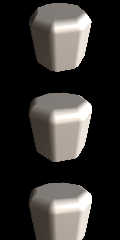|
 |
This is something I made a long time ago (incidentally for my newest version
of the Millennium Falcon, which is about as finished as my plans to conquer
the world.. With that difference that I do plan to complete the Falcon one
day :)).
It's a collection of subdivision-macros, but they don't work in the usual
subdivision-like way. Most subdivision-systems smooth the object to where
the original shape is barely recognizable. My macros try to recreate the
intended shape.
So, for example: in the top-left of the image you have a very crude cylinder
(bottom-left is the version with normal triangles instead of
smooth_triangles). Most subdivision-systems would create a cylinder-shaped
object with a radius far less than what the original cylinder seemed to be,
my subdivision-system subdivides the triangles creating the objects in the
top-right (smooth_triangle) and bottom-right (triangle).
The way this is done, is by recursively subdividing a patch (a quad or a
triangle) in 4 (or 3 for a triangle) sub-patches (or in the case of the
image: in 2 sub-patches, since there was no need for 4 sub-patches).
Maybe some ascii-art will help me explain it :)
A quad has 4 points:
P1-------P2
| |
| |
P3-------P4
Every point has a normal, N1 to N4. The macro tries to find points/normals
P12/N12, P13/N13, P24/N24, P34/N34 and P1234/N1234
P1----P12----P2
| | |
P13--P1234--P24
| | |
P3----P34----P4
so that P1, P12 and P2 are on the a ellipse where the normal of the ellipse
at P1 is N1, and the normal of the ellipse of P2 is N2. N12 then is the
normal of the ellipse at P12. (The other points are analogous, as is the
case with a triangle-patch).
Then, if needed, every subpatch again gets subdivided, or drawn using
(smooth_)triangles. The result is a subdivided patch where the original
given points stay in the same place, making it, IMHO, far easier to control.
just thought I'd share this :)
cu!
--
#macro G(b,e)b+(e-b)*C/50#end#macro _(b,e,k,l)#local C=0;#while(C<50)
sphere{G(b,e)+3*z.1pigment{rgb G(k,l)}finish{ambient 1}}#local C=C+1;
#end#end _(y-x,y,x,x+y)_(y,-x-y,x+y,y)_(-x-y,-y,y,y+z)_(-y,y,y+z,x+y)
_(0x+y.5+y/2x)_(0x-y.5+y/2x) // ZK http://www.povplace.com
Post a reply to this message
Attachments:
Download 'subdivisiontests.jpg' (28 KB)
Preview of image 'subdivisiontests.jpg'

|
 |
|
 |
a second set of images, I think here it's clearer what's happening :)
First the object without subdivision, then 3 times subdivided, then 5 times
subdivided but with normal triangles. As you can see, the lighting on the
bottom object is almost identical as the one on the first two, this means
the geometry of the third object is the implied geometry of the first.
cu!
--
#macro G(b,e)b+(e-b)*C/50#end#macro _(b,e,k,l)#local C=0;#while(C<50)
sphere{G(b,e)+3*z.1pigment{rgb G(k,l)}finish{ambient 1}}#local C=C+1;
#end#end _(y-x,y,x,x+y)_(y,-x-y,x+y,y)_(-x-y,-y,y,y+z)_(-y,y,y+z,x+y)
_(0x+y.5+y/2x)_(0x-y.5+y/2x) // ZK http://www.povplace.com
Post a reply to this message
Attachments:
Download 'subdivisiontest2.jpg' (53 KB)
Preview of image 'subdivisiontest2.jpg'

|
 |




![]()